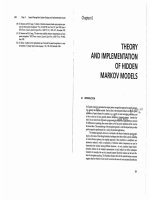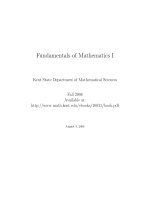FUNDAMENTALS OF BIOTECHNOLOGY
Bạn đang xem bản rút gọn của tài liệu. Xem và tải ngay bản đầy đủ của tài liệu tại đây (933.99 KB, 42 trang )
FUNDAMENTALS OF
BIOTECHNOLOGY
Lecture # 08
Study!!
•
Linkers & Adaptors
•
Selection and Characterization of rDNA
•
cDNA Libraries
•
DNA transformation
Linkers and Adaptors
•
Sticky ends are desirable for DNA cloning
experiments.
•
Provided by treating the target and vectors with
same R.E or with different but producing the
sticky end.
•
But some time target DNA blunt ended
•
So therefore we will have to use Linkers and
Adaptors.
Linkers
•
Synthetic , Short and known double stranded
oligonucleotides sequence.
•
Having blunted ends on both sides and R. Sits.
•
Treatment with R.E produces sticky ends after ligation
with target DNA.
•
e.g. Linker having sit for BamHI.
•
Drawback if target DNA also having the same R. Site
then?
•
(Please use the book notes for detail).
•
A Synthetic dstranded Oligonucleotide having
blunt end and Sticky end.
•
Blunt ends will bind to the blunt ends of target
DNA to produce new DNA with sticky ends.
•
Problems: sticky of adaptors will binds with each
other so….
•
Treatment with Alkaline Phosphates.
•
After attachment with target…… treatment
•
Polynucleotide Kinase to add P–OH at 5 prime.
Homopolymer tailing (HT)
•
Homopolymer: A strand composed of one type of
nucleotide.
•
HT: the in-vitro addition of the same nucleotide by
the enzyme terminal deoxynucleotide transferase
to 3’-OH of a duplex DNA molecule. (calf
thymus).
•
e.g. Complimentary poly (C) and poly (G) for
vector and target DNA respectively.
Characterization of rDNA
Selection and Characterization of rDNA
•
Identification and selection of rVector:
•
Desirable antibiotic resistance
e.g. Ampicillline and tetracycline
•
plaque formation:
X-gal
•
Next step is to know which one contains our DNA of
interest.
•
Genetic Method (Resistance, Color, plaque formation).
•
Immunological screening: (inserted gene will produce
protein Ags and Abs reaction based)
•
Hybridization method:
Prob will be hybridized with the corresponding DNA.
•
DNA Sequencing:
•
Southern and northern hybridization analysis
•
Western blot for protein analysis
Screening and characterization of rClones
Selection with antibiotic resistance
(amp
r
)
Twin antibiotic resistance
Blue-white screening
Restriction digestion and Gel Electrophoresis
Hybridization to identify the interested
DNA or its RNA product
1. Radiolabeled probes which is complementary to
a region of the interested gene
Probes:
An oligonucleotide derived from the sequence
of a protein product of the gene
A DNA fragment/oligo from a related gene of
another species
1. Blotting the DNA or RNA on a membrane
2. Hybridize the labeled probe with DNA
membrane (Southern) or RNA (Northern)
membrane
Screening by Hybridization
Probes: DNA or RNA
100+ bp in size good
Sequence match >80% best
Stringency conditions
Screening Colonies by Hybridization
•
Nucleic acid probe
•
Cells transferred to
nylon membrane and
lysed
• DNA binds to
membrane, is denatured
and probe hybridized
• Bound probe detected
by autoradiography after
washing membrane
Screening by Immunological Assay
Screening by Functional Complementation
•
Requires strain unable to
produce desired
product/function
•
Cloned DNAs must be in
expression vector or
include elements required
for expression
•
Select for restoration of
lost function
Southern and Northern blotting
Identify the protein product of an interested
gene









